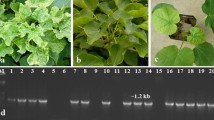Abstract
Hollyhock (Alcea rosea, family Malvaceae) is an ornamental plant grown widely in gardens across South Asia. In a bed of ornamental plants near the village of Chakri (Punjab Province, Pakistan) in 2014, hollyhock plants showing two distinct symptom types were identified: yellow vein mosaic and leaf crumple. PCR amplification with universal primers amplified a begomovirus from separate nucleic acid extracts of single plants of each type but amplified a betasatellite only from the plant with the yellow vein mosaic symptoms. No potential begomovirus DNA B component or alphasatellite could be identified in either sample. After cloning, the genome sequences of two viruses, one from a plant of each symptom type, were determined and shown to share 99.9% nucleotide sequence identity with each other but less than 91% nucleotide sequence identity with all previously characterized begomoviruses, with the highest identity (90%) to an isolate of pedilanthus leaf curl virus (PeLCV). This indicates that the two hollyhock plants were infected with a newly identified begomovirus for which the name "hollyhock vein yellowing virus" (HoVYV) is proposed. HoVYV likely has a recombinant origin. The betasatellite showed the highest nucleotide sequence identity to an isolate of cotton leaf curl Multan betasatellite (CLCuMuB), a betasatellite associated with cotton leaf curl disease across Pakistan and northwestern India. These findings add to the diversity of known begomoviruses in South Asia and again highlight the role of hollyhock as a reservoir of the cotton leaf curl begomovirus betasatellite complex. The results also suggest that the yellow vein mosaic symptoms in hollyhock are due to the betasatellite rather than the virus.

Similar content being viewed by others
Availability of data and material
Data are available with supplementary figure and tables.
Code availability
DNAStar, MEGA X.
References
Altschul SF, Gish W, Miller W, Myers EW, Lipman DJ (1990) Basic local alignment search tool. J Mol Biol 215:403–410
Argüello-Astorga GR, Ruiz-Medrano R (2001) An iteron-related domain is associated to motif 1 in the replication proteins of geminiviruses: identification of potential interacting amino acid-base pairs by a comparative approach. Arch Virol 146:1465–1485
Briddon RW, Bull SE, Mansoor S, Amin I, Markham PG (2002) Universal primers for the PCR-mediated amplification of DNA β; a molecule associated with some monopartite begomoviruses. Mol Biotechnol 20:315–318
Briddon RW, Bull SE, Amin I, Idris AM, Mansoor S, Bedford ID, Dhawan P, Rishi N, Siwatch SS, Abdel-Salam AM, Brown JK, Zafar Y, Markham PG (2003) Diversity of DNA β: a satellite molecule associated with some monopartite begomoviruses. Virology 312:106–121
Brown JK, Zerbini FM, Navas-Castillo J, Moriones E, Ramos-Sobrinho R, Silva JF, Fiallo-Olivé E, Briddon RW, Hernández-Zepeda C, Idris A, Malathi VG, Martin DP, Rivera-Bustamante R, Ueda S, Varsani A (2015) Revision of Begomovirus taxonomy based on pairwise sequence comparisons. Arch Virol 160:1593–1619
Bull SE, Briddon RW, Markham PG (2003) Universal primers for the PCR-mediated amplification of DNA 1: a satellite-like molecule associated with begomovirus-DNA β complexes. Mol Biotechnol 23(1):83–86. https://doi.org/10.1385/MB:23:1:83
Doyle J (1991) DNA protocols for plants. In: Hewitt GM, Johnston AWB, Young JPW (eds) Molecular techniques in taxonomy. Springer, Berlin, pp 283–293
Jose J, Usha R (2003) Bhendi yellow vein mosaic disease in India is caused by association of a DNA β satellite with a begomovirus. Virology 305:310–317
Kumar M, Vinoth Kumar R, Chakraborty S (2020) Association of a begomovirus-satellite complex with yellow vein and leaf curl disease of hollyhock (Alcea rosea) in India. Arch Virol 165:2099–2103
Martin DP, Murrell B, Golden M, Khoosal A, Muhire B (2015) RDP4: detection and analysis of recombination patterns in virus genomes. Virus Evol 1:vev003
Muhire BM, Varsani A, Martin DP (2014) SDT: a virus classification tool based on pairwise sequence alignment and identity calculation. PLoS ONE 9:e108277
Sattar MN, Kvarnheden A, Saeed M, Briddon RW (2013) Cotton leaf curl disease—an emerging threat to cotton production worldwide. J Gen Virol 94:695–710
Saunders K, Bedford ID, Briddon RW, Markham PG, Wong SM, Stanley J (2000) A unique virus complex causes Ageratum yellow vein disease. Proc Natl Acad Sci USA 97:6890–6895
Srivastava A, Kumar S, Raj SK, Pande SS (2014) Association of a distinct strain of hollyhock yellow vein mosaic virus and Ludwigia leaf distortion betasatellite with yellow vein mosaic disease of hollyhock (Alcea rosea) in India. Arch Virol 159:2711–2715
Tahir M, Haider MS, Briddon RW (2010) Complete nucleotide sequences of a distinct bipartite begomovirus, Bitter gourd yellow vein virus, infecting Momordica charantia. Arch Virol 155:1901–1905
Tamura K, Stecher G, Peterson D, Filipski A, Kumar S (2013) MEGA6: molecular evolutionary genetics analysis version 6.0. Mol Biol Evol 30:2725–2729
Zerbini FM, Briddon RW, Idris A, Martin DP, Moriones E, Navas-Castillo J, Rivera-Bustamante R, Varsani A, Consortium IR (2017) ICTV virus taxonomy profile: Geminiviridae. J Gen Virol 98:131–133
Zhou X (2013) Advances in understanding begomovirus satellites. Ann Rev Phytopathol 51:357–381
Acknowledgements
MT would like to thank HEC, Pakistan, for providing funds for the conduct of research.
Funding
The project was funded by Higher Education Commission of Pakistan under Grant No. 1689.
Author information
Authors and Affiliations
Contributions
AK and YI conducted the experiments, MT analyzed the data and wrote the manuscript, and RWB validated the data analysis and reviewed the manuscript.
Corresponding author
Ethics declarations
Conflict of interest
The authors declare no conflict of interest.
Ethical approval
No ethical approval was required, since no experiments involving humans, animals or transgenic organisms were performed.
Additional information
Handling Editor: Jesús Navas-Castillo.
Publisher's Note
Springer Nature remains neutral with regard to jurisdictional claims in published maps and institutional affiliations.
The database accession numbers for the nucleotide sequences reported in this paper are LK028571, LK028572 and LM645009.
Supplementary Information
Below is the link to the electronic supplementary material.
Rights and permissions
About this article
Cite this article
Khan, A., Imtiaz, Y., Tahir, M. et al. Complete genome sequence of hollyhock vein yellowing virus, a novel monopartite begomovirus infecting hollyhock in Pakistan. Arch Virol 166, 2607–2610 (2021). https://doi.org/10.1007/s00705-021-05134-7
Received:
Accepted:
Published:
Issue Date:
DOI: https://doi.org/10.1007/s00705-021-05134-7




